
Well, we had arrived to the land of extremes. A country proclaimed by many to be an “assault on all your senses…” the “love it or hate it“ destination. Oh India… you are indeed one-of-a-kind and without equal.
Our first stop in India was one that does not attract a lot of foreign tourists, but since we scored a cheap flight from Ethiopia, we inadvertently found ourselves well off-the-beaten-path in Lucknow, India. Lucknow is an Indian capital city yet considered to be a “small” Indian metropolis of 2.8 million that is located in the northern state of Uttar Pradesh (aka, UP.) You will struggle very hard to find any other western tourists walking around in Lucknow. In fact, we didn’t see a single other Caucasian out and about.
Our journey to India actually started from Addis Ababa, Ethiopia. It all started at 11 pm, arriving early for our 4 am flight because we could not manage to arrange transport to the airport any later. So, we arrived early, and waited for our red-eye flight with the plethora of slumped over passengers probably also stuck in the same conundrum.
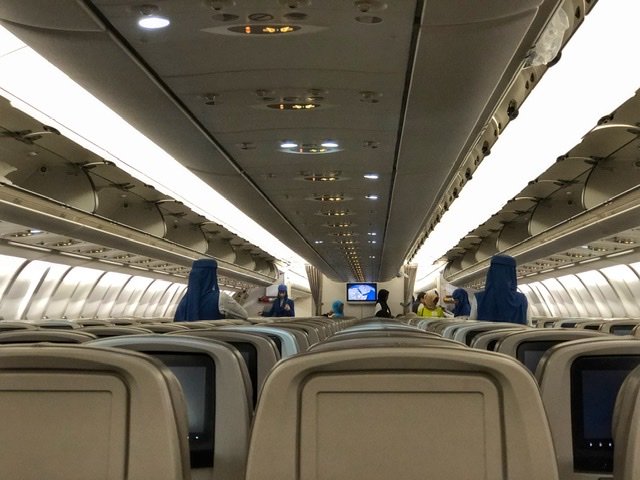
Getting into Lucknow
After the ridiculously early departure, we were delighted to be greeted by the striking Arabian flight attendants on board this Boeing 747 Saudia Airlines flight which was shockingly empty of passengers… only about 40 were on this HUGE airplane. Oh yes, this meant really stretching ourselves out to occupy our very own four seat rows, with actual snoozing that transpired.

Flying into the (for us) no go zone of the Kingdom for two hours and not getting to include Saudi Arabia on our country count was a major bummer. The view from the airplane as it descended towards Riyadh was, alas, all we would get to see of the stark desert landscape surrounding it. Obviously not sure when, or if we’ll make it back here to get a much closer look!
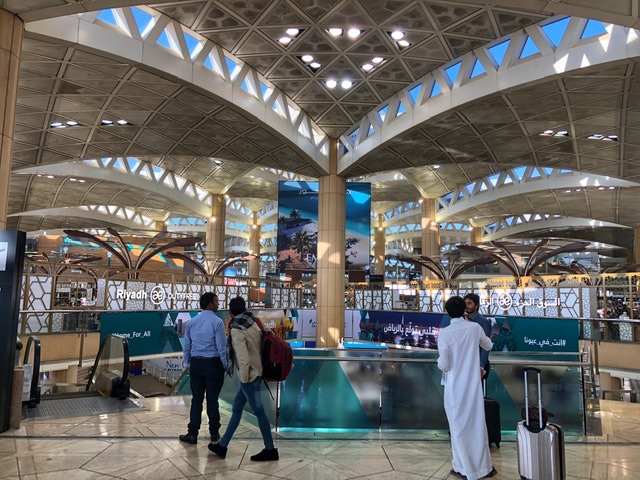
The opulent, glitzy airport terminal in Riyadh was dripping with consumerism and more than a little shocking to our systems after our time in Ethiopia where outside of Addis, we struggled to find even basic necessities.
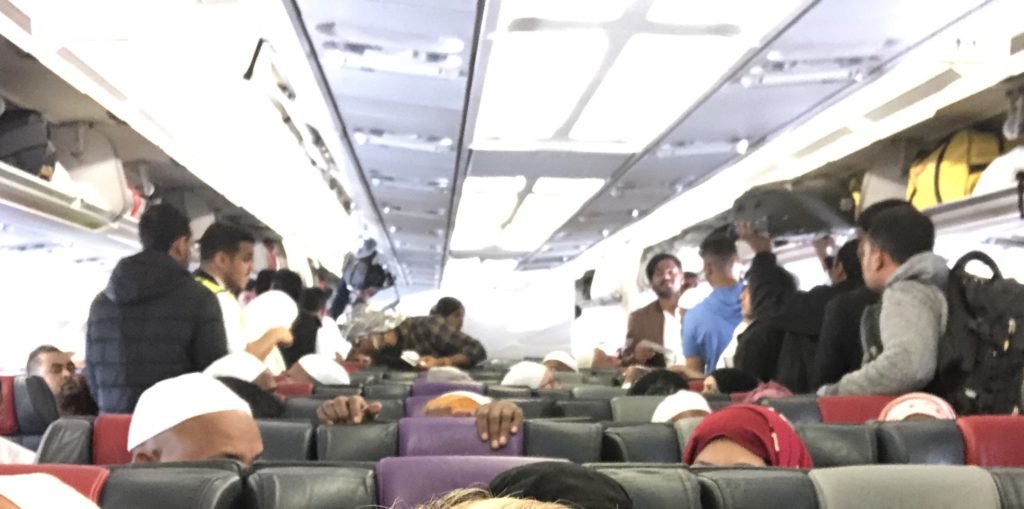
Our introduction to India actually began from the moment we climbed aboard the next five-hour flight to Lucknow from Riyadh. At the gate, we immediately became aware of how, um… white, we were. In fact, of the hundreds on board the plane, we were the fairest of them all. Except for one lone flight attendant who looked like a typical Norwegian, and spoke English with a South African sounding accent. We quietly wondered what his story was. We were further confounded when he took to the PA and, in fluid Arabic, made announcements over the loudspeaker. Later we got the chance to chat with him and learned that he was, in fact, 100% Egyptian.
In addition to being the palest people on the plane, we also began to realize we might have been the only other passengers who had ever flown before. This was by far the strangest on-boarding experience we have ever had In our lives. It began with the pushing and shoving in a irrational rush to get on board, as if we had not been assigned seats. Then, the shoving and pushing gave way to utter confusion of how to proceed with the assigned seating system that planes operate on. A complete and total befuddlement ensued where nearly every other passenger cluelessly fumbled around trying to understand the notion that, first of all, we all had assigned seats, and second that each seat had In fact a number attached to it that corresponded to the seat number on your ticket. Total mayhem… But, once we found and promptly seated ourselves we became transfixed by the scene playing out in front of us as bags were hopelessly shoved into entirely too small of holes, and others continuously tried like salmon, to make their way upstream in the aisles after passing their seats. In short, they seemed to be leading all the flight attendants within sight to a nervous breakdown. We later found out from a flight attendant that many of them, in fact, HAD never flown before. They were Muslim Indians returning from Hajj on their once-in-a-lifetime pilgrimage to Mecca.
Understanding the flight attendants’ frustration after years in hospitality, during our meal, Mandy leaned over and whispered to one of the attendants, “I just want you to know, you all are doing a really great job.” The attendant looked overjoyed with appreciation at this compliment.

Before long, one of the attendants came over to us and said they’d like to move us to the Bulkhead, the front row with ample leg room. From that point forward, they began catering to us left and right despite us saying it really wasn’t necessary.
When we arrived to the airport in Lucknow, it was near instant utter chaos. Fortunately, an official grabbed us immediately, took us aside and helped fill out the immigration paperwork FOR us (which is unheard of), before checking our E-Visas and whisking us to the front of the mob. They officials efficiently and speedily stamped us into India.

Then, time for another loopety loop on this wild ride. With no signage anywhere, we followed the herd through a security screening with our carryon bags and then were crammed into a tiny area filled with Indians yelling and lots of those stupid little luggage carts to run us over. Everyone was shoving to get to the baggage belt. If they had horns attached to those luggage carts, the sound would have been deafening. With two belts, and no sign, we didn’t know which one was ours so Greg waited at belt one while Mandy was bounced like a pinball to try and check out belt two. Unsuccessful, she returned. Greg tried again, and like a knight in shining backpack armor, emerged holding both bags on his shoulders which had been tossed on the floor like a crate of chickens in the middle of this chaos.
We then had to go through the same security screening one more time, this time with our bags. Again, fortunately we managed to get scooted to the front of the line and out the door where and official announced with a wry smirk, “Welcome to India” and knowing head wobble.
Uber has, thank God, come to some parts of India. We fired up our phones and got an Uber on the way to pick us up. Getting to our Uber was another detour in itself however, but we finally found each other and he guided us through 10 minutes of incessant honking before gliding us onto the speedy freeway. We were dropped off 40 minutes later to our serene Airbnb and paid 372 Rupees (an insane $5) for a rush hour ride of that length from the airport.
Afterwards, we sat in our room reflecting on what we had just witnessed as our introduction to India and enjoying the tea our Airbnb host left us, along with the sack of sodas, juice and water our flight attendants gave us as a parting gift. All for telling them good job. Oh, India…
The next day, we got a crash course in what “an assault on your senses” actually means. It actually electrifies your senses. Within moments of taking our first tentative steps onto the first Indian street from our serene AirBnB enclave, your eyes are taking in the colors, the flowers, the chaos of every business piled atop one another, the people urinating on the road. Which brings us to smells…yes, lots of aromatic nose scrunchers, blended with an occasional whiff of a delightful-smelling curry or spice. And the sounds…people don’t just beep their horns here. They appear to lay their hand on the horn and simply not remove it.
With all of this new stimuli, the feeling is utter discomfort and trepidation mixed with excitement and vigor. After all, just walking in India is scary. Tuk Tuks, motorbikes and cars zip incessantly around cows, goats, and stray dogs. There are no traffic lights, no crosswalks, no order of any kind. It’s an absolute miracle that the whole city is not a heap of traffic accidents and injured cows and pedestrians. But it all seems to work…for them.

Architecture of Lucknow
This was the experience of getting from Point A to Point B. However, once you arrive at Point A or Point B, India was a whole new world of architecture for us to absorb and appreciate…enchantingly intricate lattice work, sweeping cupolas, undulating arches upon arches, and even graceful minarets which have a uniquely Indian flair, all in flawless symmetry. Lucknow saw some of the last days of Islamic rule in India, and because of this was heavily influenced by Islamic building styles. Lucknow is not an especially appealing stop for most tourists who visit India, and is perhaps best known abroad for a five-month siege in 1857 upon its British residents. Less remembered, are the atrocities committed by the British occupiers when they subsequently recaptured the city. The juxtaposition between the truly remarkable architectural showpieces of Lucknow, the wonderful immersion of being so far from the Indian tourist trail, and its utterly chaotic street scenes left us feeling… well, confused about our first impressions of India. Which is just as well, because we’ve got a lot more to explore!

The Asfi Mosque is undoubtedly a showpiece of Lucknow star attractions. The mosque is part of the much larger Bara Imambara Mosque Complex, which means fittingly “big.” The building is placed on a two-tiered arcade plinths and has two wonderful soaring minarets flanking it. Unfortunately for us, It’s closed to non-Muslims so we just got a peak of the exquisite exterior from the roof of the nearby Imambara.

An imambara is a congregation hall where Shi’ites Muslims gather together. From this roof, looking around at the surrounding architecture (and listening unavoidably to the cacophony of vehicle horns) it was easy to utter to ourselves and aloud…”wow, we’re certainly in India!”
This lofty perch is also where we first began encountering the casual Indian paparazzi. Or, local sightseers who found it fitting to slyly snap selfies and group pictures of themselves and a couple of white tourists like us, even though we were complete and total strangers. Particularly with Mandy. It was an interesting role reversal… normally we’re the sly picture takers, of them. But, here, we became the tourist attraction. Literally. However, we definitely weren’t prepared for an entire family of about 20 locals approaching us and asking to take selfies with us (with naturally at least 10 different smartphones.) This was fun the first few dozen times, but then got a bit much. At least we now know what it feels like to be “famous.” ?
Other views of the lovely Asfi Mosque.

Inside the imambara from 1786. Evidently, it boasts one of the largest vaulted halls in the world at 50 meters long and 15 meters high. Check out the mini windows up high. All of these are connected to an intricate upper labyrinth that hooks and molds its complicated maze-like corridors around this ceiling.
One hall of the labyrinth that weaves itself above the Imambara hall. We had so much fun winding through the entangled corridors (shoeless, because that’s the rules and… well, we also were keen to share foot germs with thousands of Indians.)

True to its name, it was a labyrinth. Take a narrow staircase, up or down a level, or turn a corner and it would blindly spit you out at one of these windows overlooking the hall. (It kind of reminded us of Indiana Jones and the Temple of Doom when Dr. Jones, the cute Chinese kid, and the whiny singer were first observing the bad guy ripping the heart out of the sacrificial man.)
Visitors are advised to enter only with guides, which we naturally turned down, preferring to get lost and because of course we’re Explorer Genes. Oh, and also you can save some rupees by ditching a guide (we’d already paid the $14 foreigner rate just to enter the complex.)
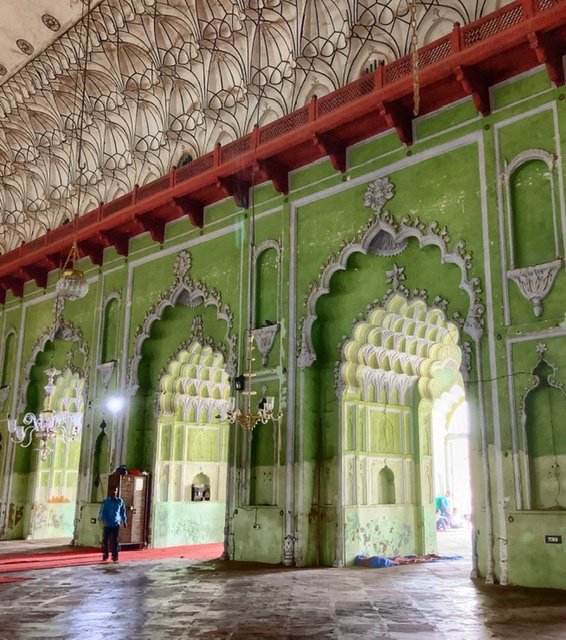
Wow, the colors and arches are just tremendous.
Spanning the width of the main road is the immense Rumi Darwaza ornamental entrance gate. It was modeled after one of the gates in Istanbul, which we apparently missed when we were there.
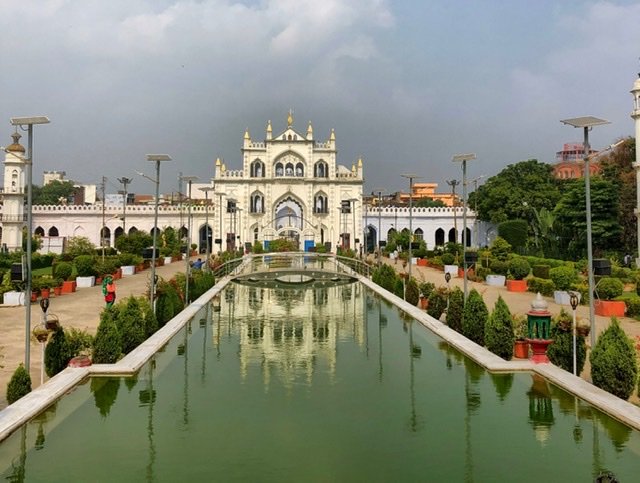
The entrance gate to another imambara, the lavish Hussainabad Imambara or ”Palace of Lights“ thanks to its fairytale appearance.
We’ve personally never witnessed a fairytale with such unflatteringly industrial pathway lights running the length of its rather beautiful reflection pool. They made for some uncomfortably tricky photographing tactics. The Hussainabad was built in 1837 by Muhammad Ali Shah, partly to provide famine relief through employment. While the outside is stunning, the inside is a bit garish.
There was even a mini Taj in this Imambara complex. We realized later, this was a pretty week rendition compared to the real deal.
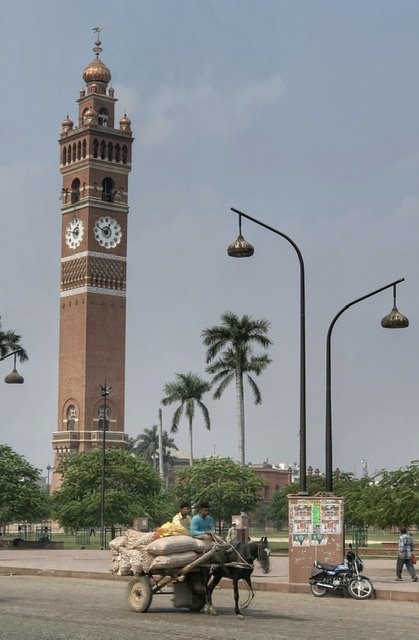
The Husainabad Clock Tower was built in 1881 to mark the arrival of Sir George Couper, the first lieutenant governor from Great Britain of United Province of Avadh (where Lucknow now is.) It was modeled after Big Ben. Speaking of British people, they’re the ones who officially changed the name Lakhnau, to Lucknow. Most likely because their mono-linguistic English tongues couldn’t pronounce it….haha. Some things never change.
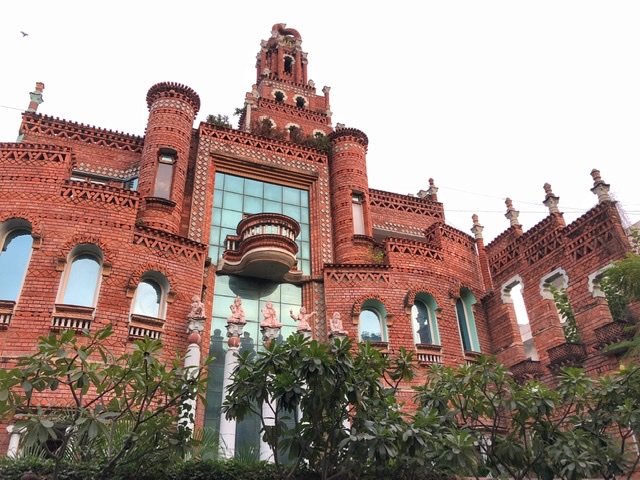
This palace is actually just a wealthy Indian’s house…a couple doors down from our Airbnb. We learned that the couple who lived here were “businesspeople” and also had a VERY fancy, prestigious-looking party the night of Diwali. Shockingly, we didn’t get an invite, what with our worn-out backpacker threads and shirts with pills all over them. ??♀️

The Ambedkar Memorial Park is certainly unlike any park we’ve ever seen…it must have been at least a hundred acres and entirely paved in marble and sandstone tiles it is opulent, grand, and immaculate. Statues and monumental buildings were as far as the eye could see, literally, it was a massive monument. Entrance cost just 15 Rupee ($0.18). It’s dedicated to B.R. Ambedkar, the 20th century Indian “father of the Indian Constitution” which is also, incidentally the world’s largest democracy.

For the record, Ambedkar inspired the Dalit Buddhist Movement (a socially and politically engaged form of Buddhism), as well as campaigned against social discrimination towards the Dalits (untouchables), the lowest people in India’s caste system. He also supported women and labor rights. Many people, us included, didn’t realize that because of him, India’s constitution is actually quite liberal and progressive. This document is also the world’s largest constitution at 145,000 words (the US by comparison is 4,400 words.) Some believe the size is actually its downfall.

Diwali in Lucknow
Unplanned, we happened to stumble into Diwali in India. Diwali is the five day “festival of lights” is a very important religious observance celebrated by Hindus, Sikhs, Jains and some Buddhists around the world. Festival traditions include strings of vibrant flowers, firecrackers, luminous lights, and of course copious and scrumptious Indian food.
Celebrating our first Diwali with our over-the-top wonderful Airbnb hosts was a special experience and window into Diwali that we’ll never forget. While Diwali holds significance for a variety of reasons, one of the core themes of the festival, as symbolised by the prevalence lights, is the triumph of good over evil.
Its commemoration is a bit different throughout India and Nepal depending on where you are. In the northern region, the day commemorates the return of Vishnu’s seventh avatar, Lord Ram and his wife Sita, (the figures of marital purity and devotion) to Ayodhya after having lived in exile for 14 years. Originally, it was the entire kingdom of Ayodhya which was lit up with diyas (oil lamps) for their welcome. Thus, a tradition was born, although in modern days it’s strings of electric lights draped on the outside of houses and tea candles inside.
It wouldn’t be Diwali without flowers to brighten everything up. They are linked together to make massive chains, placed in floor arrangements, vases, everywhere. It’s very common to see people on the streets preparing these decorations, typically marigolds, for sale in the days preceding Diwali.

Diwali runs for five days and there is a lot of differing info on specific Diwali traditions depending on where you live and who you ask. According to our hosts and some other local sources, however…
Day 1: is about worship to Lakshmi, the goddess of fortune or money, where Hindus should buy something. Often money itself is ceremonially “cleansed” by washing it in milk, to symbolise the renewal of good intentions towards it and the motivation to use it to benefit family and the greater good. However, we noticed a lot of locals shopping at the Big Bazaar when we went in…
Day 2: Cleaning…this is when you clean your entire home, and your bodies, as Lakshmi will only enter a clean environment. They also prepare their rangoli. (See upcoming picture)
Day 3: The main day of Diwali where a very large meal is prepared and eaten, people dress up, light firecrackers, and houses are lit. Lights are the focus. People often play cards or gamble after dinner as well.
Day 4: Kites are flown. We’re not sure exactly what this represents, but this is also the Hindu New Year.
Day 5: A celebration of siblings when you buy gifts or do nice things for your brothers or sisters.
No matter how you celebrate, it’s a time of hope, happiness and peace which we were ecstatic to be a part of.
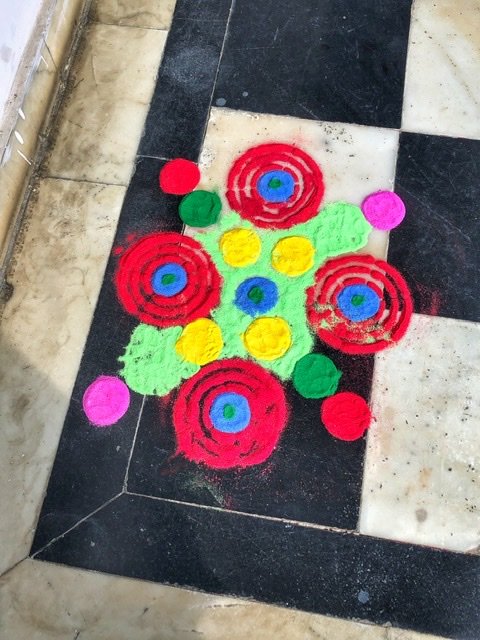
During the five days of celebration, people decorate their home with rangoli…a colorful artwork made with rice powder. Rangoli powder comes in many colors and the porch of one’s home is often decorated with beautiful designs. They can also be made with flowers or colored sands. It is another way to ring in the festive spirit. (Culture Trip)
Walking out of our room the third (and biggest) night of Diwali, we were greeted with diyas (tea candles) trailing down the stairs, an exceptionally welcoming family who clearly treated us well, and the absolute best meal we had in India. Everything was delectable. In addition to an incredible meal, our hosts were a real pleasure to converse with. Well educated, well-traveled, and well-spoken, and we had stimulating conversations on everything from history, to politics (new and old) and law, to cultural insights like the caste system and differences and similarities between our two countries.

Mandy with Mama Prem and daughter Shipra. Mom (and dad) are lawyers and Shipra was an economist who lives in Delhi and had also studied at NYU for a while. Such lovely people whom we’ll never forget.

And their home was equally as lovely. We stayed in a room at the front with a balcony ($23/night). The mom, Prem basically just rents it out on AirBnB to meet fellow travelers, which worked out well for us as we enjoyed meeting and sharing with them too.
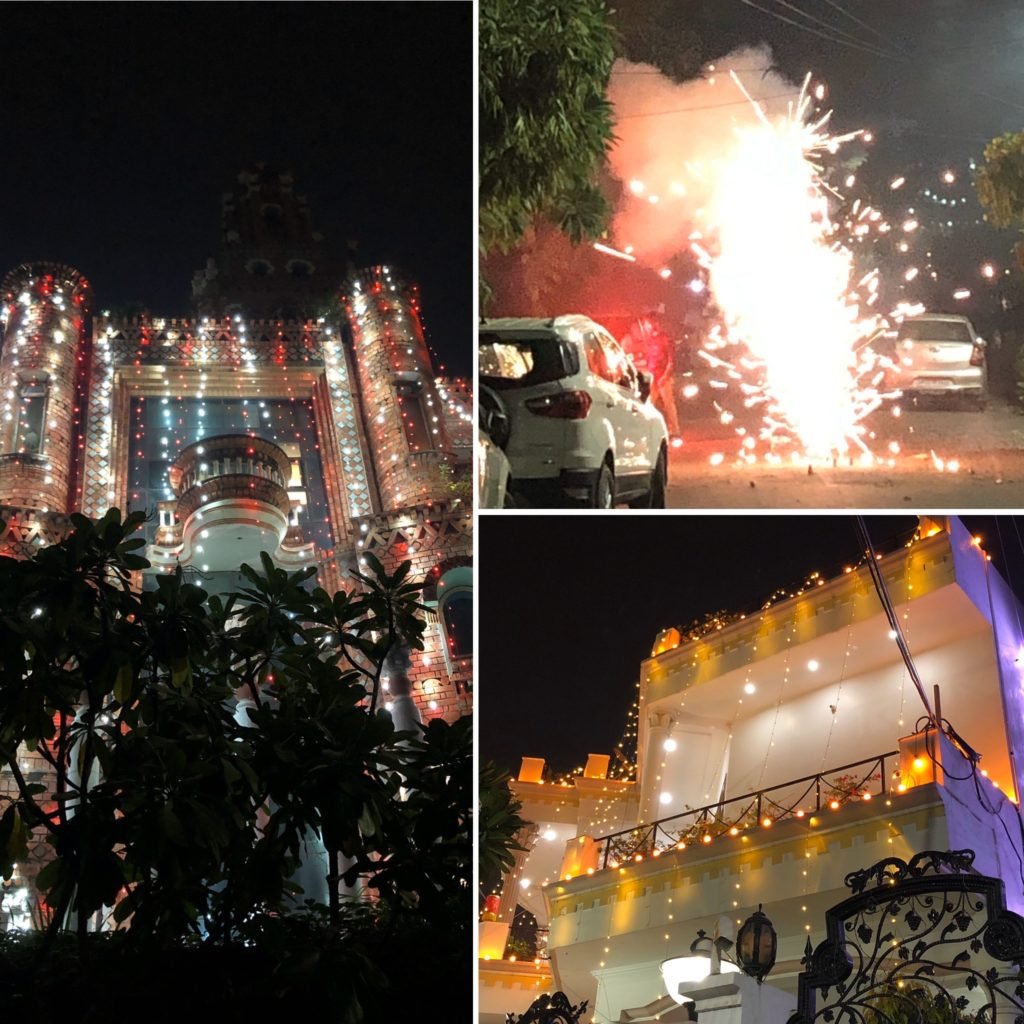
After Diwali dinner, we took a walk around the area with Shipra. The relentless honks and horns of the daytime had been replaced by blasts of fireworks and pops of crackers. With an addition of houses decorated like our Christmastime, a war zone of fireworks felt a lot like how we celebrate our Independence Day. Sadly, these fireworks, along with harvest burning season, creates some of the most hazardous pollution measurable in India which lingers for weeks on end. We were glad to be heading north for this reason and hoping it would be gone upon our return to Delhi.
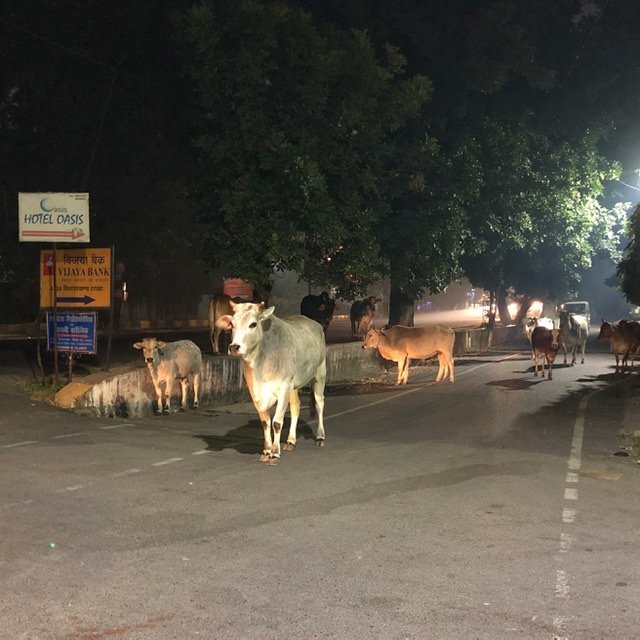
In addition to the human challenges, the ones who suffer the most on Diwali are the roaming animals in the streets…mostly street dogs and cows. It was sad to so many stressed out looking anxious animals. The cows on our walk, which normally roamed independently, congregated together the night of Diwali.
As you can imagine, when many members of the Islamic community want to eat beef and essentially, treat them as animals, there’s a lot of controversy over the roaming cows, which are sacred to Hindus. This public works project, however, is interesting as a symbol of unity. On it, you can see icons of all many different religions, including a giant black rabbit, which kinda reminds us of an ”adult” toy…haha, yes…that one is a bit of a mystery!

But at least to us, seeing cows nosing through trash pits, eating old plastic bags, and dodging traffic didn’t really seem like a way to treat them either.
Quick aside….we were beyond thrilled to see NO plastic bags currently in use in Lucknow. The fruit sellers all provide reusable, non-plastic bags and most people carry baskets. Kudos Lucknow. That is very positive progress! We aren’t sure if this wonderful initiative is across India, but we certainly hope so.

The day of the dinner, we also tried to visit Sheroe’s Hangout. Unfortunately, due to the Diwali holiday, it was closed but because of its mission. In spite of its holiday closure, As a cafe and outreach center for the victims of acid attacks, we felt prompted to both learn more about the horrific crime of acid attacks that is too common in India, and try to promote the mission of Sheroe’s Hangout.
Apparently 85% of these attacks are on women perpetrated by vengeful men who were abusing the victim (and she fought back), or rejected by the victim. With a toss of some acid, these women’s faces become permanently disfigured or mutilated (often with the thinking that “no other man will want her”) and undoubtedly suffer unimaginable trauma and social exile. The victim also suffers in loss of income and opportunity. In the past, these women were told to “cover up” their faces but now they are fighting back and creating lives for themselves through these NGO cafes which create awareness, self confidence, and power. We’ll definitely seek out the next cafe possibility.
Getting OUT of Lucknow
One of the major downsides of Diwali was the horrific crowds when it came to train and bus travel. We couldn’t get a logical train ticket so we ended up taking a HUGE detour through Lakhimpur by train and then had the good fortune of taking two shared “taxis” and three tuk tuks to reach the India/Nepal border where we stayed the night in Nepalgunj. A four-hour journey ended up taking 10 and left us battered and bruised.
And, for the record, this is what an Indian shared taxi looks like, nicely summarized by this child’s irritated expression. The taxi resembled a clown car, particularly with the teensy tuk-tuk sized wheels and accompanying circus horn which was blasted every two to three minutes. We hadn’t felt so close to one another in a long time…or to all of these fine people. In fact, the pictured woman’s ass was wedged between Mandy and another person and cutting off the circulation to most of Mandy’s left thigh for a solid two hours. But, in the end we got to where we needed to go. ? Oh….India…❤️


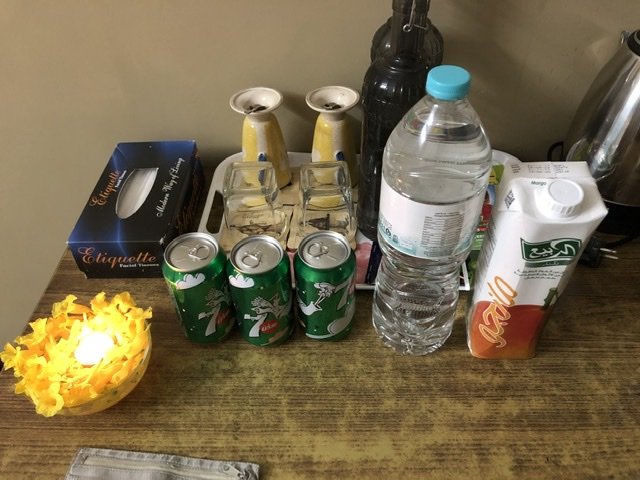


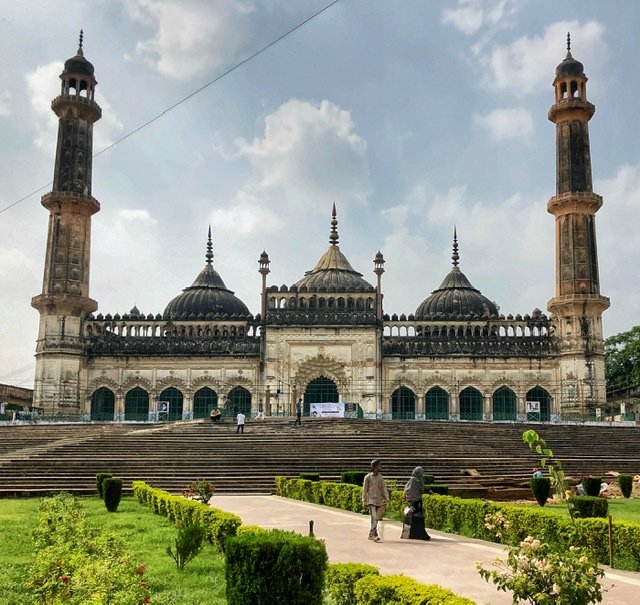

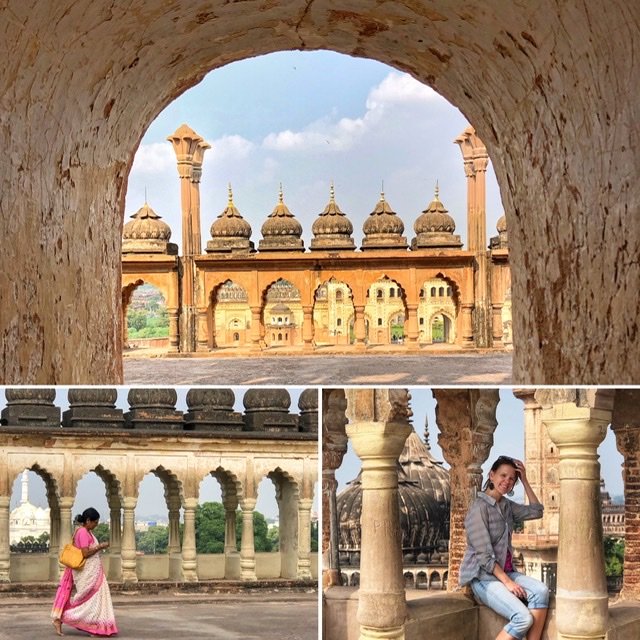
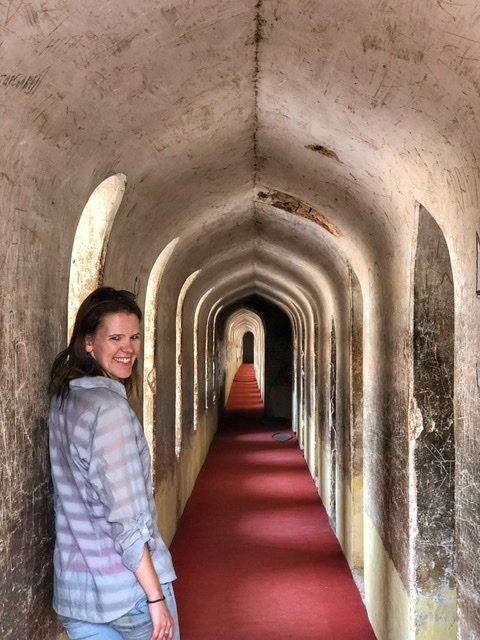

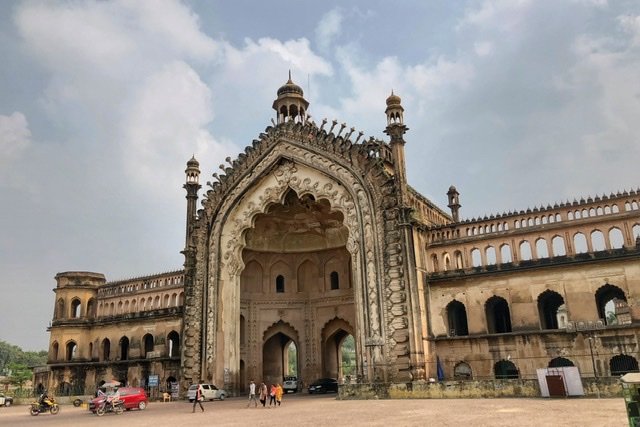



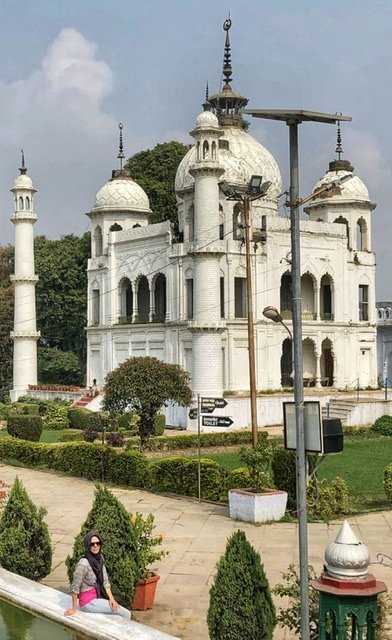


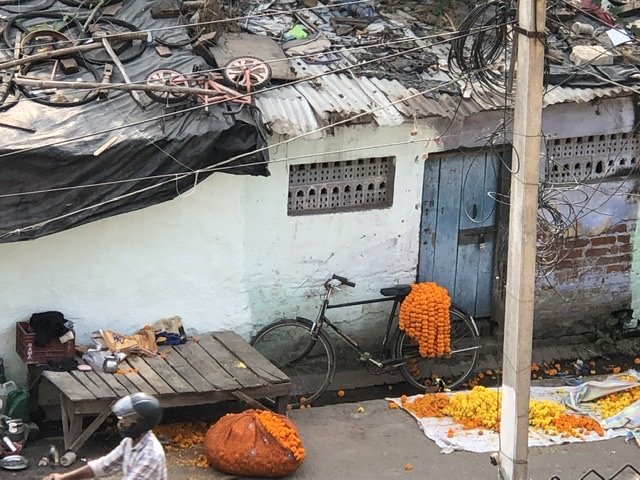





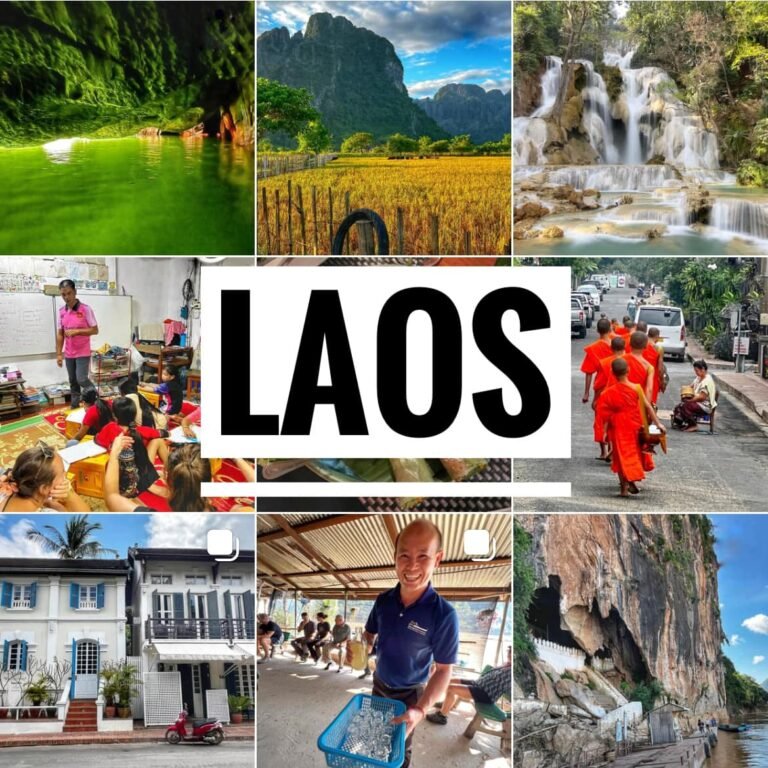

Re: Shared Taxis – When Megan and I were in India we soon learned to use our white privilege and buy an entire row in a taxi. We could afford it, and besides, a Western butt is at least 1-1/2 times the size of the Indian version!
Hahaha!! That’s brilliant! That idea would probably get the taxi on the road quicker too, instead of waiting for it to fill up. Thanks for the tip! 🙂